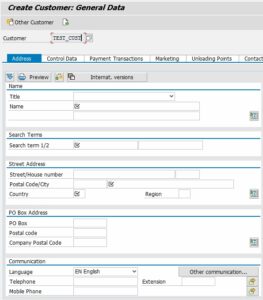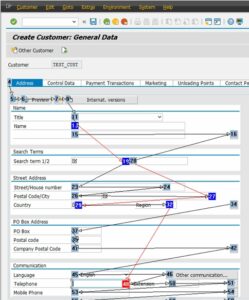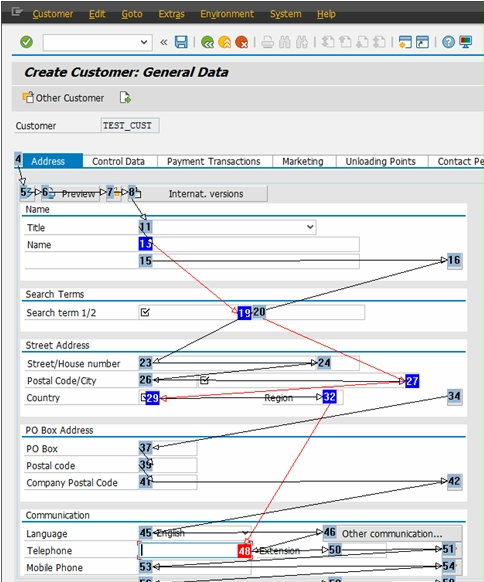A colleague brought this to my attention recently as we were brain storming solutions for a customer request. I had assumed that a programmer would be required when asked to change the tab sequence on a custom screen that we had previously created. I was wrong. The SAP GUI Tab Order can be changed!
The Setup
I’ve been using SAP GUI 7.30 for months now, and it’s amazing that new features have been right under my nose this whole time. I chalk that up to SAP poorly promoting the new features. I mean… Seriously? How difficult is it to have a walkthrough built into the SAP GUI installer? Anyways, I digress. Let’s go back to the customer’s issue we were trying to solve.
An ABAPer I work with had previously developed a customized tab on Purchase Requisitions, Purchase Orders and Purchasing Contracts which included a series of custom fields. During development, the programmer added the fields in a logical sequence based on the customer’s requirements. However, months after implementation, we were informed that the individuals inputting data into these fields have a specific workflow they follow during data entry. Unfortunately, their workflow does not play nicely with the Tab sequence on the screen. Basically, the user inputs data into the first field and then must hit the Tab key several times to input the next value. Further, the user routinely has to Shift-Tab to return to a previous field to input data. When keystrokes matter, it is important to understand the user’s workflow. To me, the obvious solution would be to have a programmer re-align the Tab sequence between those fields. But questions arise: How do you ensure you are making screen input efficient for all users — not just the ‘squeaky wheel’? As it turns out, a method exists to please every single user and it’s built right in to SAP GUI 7.30.
SAP GUI 7.30 – CUSTOM TAB ORDER
The objective is to create a user-specific sequence of fields. To see the existing Tab order, you can do two things: (a) press the Tab key and advance through all the fields on the screen, or (b) use SAP GUI to show you. The secret lies in a super-secret Ctrl-Right-click menu.


In SAP, right-click on an empty field and you will see a list of options. Now, hold down the Ctrl key and do the same thing. You will notice a few extra options.
As an example, let’s use the Address tab on the General Data view in the Create Customer transaction (XD01). Let’s assume that the user creating these customers wants to jump through only the required fields during

processing. Ctrl-Right-Click on one of the empty fields and select the “Visualize Local Tab Order” option. SAP then overlays a numbered mapping of the field sequence. Altering this sequence is done using some of the other menu options.

Let’s say that we want to tab through fields in the following sequence:
- Name 1
- Search Term 1
- City
- Country
- Region
- Telephone
Place your cursor in the Name 1 field, Ctrl-Right-Click on it, and select the “Local Tab Order: From Element” option. Since we are going to the Search Term 1 field next, Ctrl-Right-Click on it and select the “Local Tab Order: To Element” option. Next, we want to jump from the Search Term 1 field to the City field. Ctrl-Right-Click on the Search Term 1 field and, again, select the “From Element” option. And then Ctrl-Right-Click on the City field and select the “To Element” option. Continue this process — the “From Element” and “To Element” — for the remainder of the series.

When completed, you can immediately test it on the active screen. Additionally, you can examine the “Visualize” option from the Ctrl-Right-Click menu to see the altered tab sequence.
One final feature I would like to point out is the “Configure Local Tab Order” option from the same menu. Selecting this option reveals a pop-up containing a list of the rules you have just created. From here, you can delete individual shortcuts as well as access the Help menu for more

information on the Custom Tab Order feature.
WRAP-UP
This hidden gem can prove to be quite useful for users with roles involving large amounts of data entry. Over time, streamlining these screens can end up saving users large numbers of keystrokes. The added bonus is that this can potentially save the IT department from making custom screen changes or from having to implement GuiXT as a workaround.










Thanks for this. Solved my Issue today as a User has accidentially activated an Exit Point and was wondering about the behavior of the Tabs… Never seen this “feature” before
I’m glad this helped you! It’s funny how hidden this feature is, and it’s funny how users are finding it. Thanks for the comment.
Great explanation Michael, it was very helpful. If I set an entry point on a specific field, do you have any idea why when I go to the transaction it still uses the SAP default entry point insted of the on I defined?
(It then goes to my entry point on first tab hit)
Regards,
Karsten
Hi,
its very help full for me, i tried but i cant find a LOCAL TAB ORDER: To ELEMENT OPTION.
Appreciate your help
Hello Michael,
Thank you for sharing. This is very useful, I have never heard of it before.I am assuming this configuration update gets stored in the local drive, can you confirm?
Thanks for commenting, Andres. I have not tried this function on any recent SAP GUI installations. But I believe your assumption to be correct that the tab order is stored and applied only to the local client. How are you planning on using it? -Michael